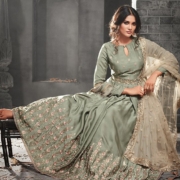Festive Wear in Pakistan Style & Heritage
Festivals in Pakistan are not just about celebration—they are a vibrant blend of tradition, family gatherings, delicious food, and most importantly, fashion. Festive wear Pakistan reflects the country’s rich cultural heritage and evolving fashion trends, making it a crucial element of every celebration. From Eid and weddings to religious and cultural festivals, the choice of festive attire carries deep significance, combining elegance, history, and modern aesthetics.
The Importance of Festive Wear in Pakistani Culture
In Pakistan, dressing up for special occasions is more than just a social norm—it’s an expression of joy and cultural pride. Whether it’s Eid-ul-Fitr, Eid-ul-Adha, or a traditional mehndi ceremony, festive wear adds to the grandeur of the event. Families spend weeks preparing for these celebrations, and selecting the perfect outfit is a highlight of the anticipation.
Traditionally, festive clothing is rooted in South Asian heritage, featuring intricate embroidery, rich fabrics, and classic silhouettes. Over the years, however, contemporary designers have fused these traditional elements with modern cuts and embellishments to meet the demands of today’s fashion-forward consumers.
Popular Styles in Pakistani Festive Wear
1. Shalwar Kameez with a Twist:
The timeless shalwar kameez continues to dominate the festive fashion scene, but with exciting modern updates. For women, designers experiment with asymmetrical hemlines, bell sleeves, peplum tops, and palazzo pants to bring freshness to the classic style. For men, embroidered collars, waistcoats, and textured fabrics elevate the traditional look.
2. Anarkalis and Angharkhas:
These flowy, regal silhouettes are ideal for formal festive occasions. With their flared shapes and detailed embroidery, anarkalis and angharkhas offer a majestic appearance. They are especially popular during wedding festivities and can be styled with churidars or straight pants.
3. Sarees and Lehengas:
For those who want to make a bold statement, sarees and lehengas are the go-to festive wear in Pakistan. Lehengas with zardozi work, mirror embellishments, and gota kinari borders are particularly favored during nikkah or baraat functions. Sarees, once considered more common in neighboring countries, have made a strong comeback in Pakistani fashion, thanks to celebrities and designers reintroducing them in contemporary fabrics like chiffon, net, and organza.
4. Fusion Wear:
As global fashion influences Pakistani style, fusion wear has gained popularity, especially among younger generations. Outfits like cape-style kurtas, dhoti pants, and crop tops paired with ethnic skirts combine traditional elements with a modern twist. These styles are ideal for semi-formal festive events and university functions.
Fabrics and Embellishments
A key characteristic of Pakistani festive wear is the choice of luxurious fabrics and intricate embellishments. Silk, chiffon, organza, jamawar, and velvet are commonly used to convey richness and opulence. Hand embroidery, dabka, naqshi, tilla work, sequins, and pearls are often hand-sewn by skilled artisans, reflecting the country’s strong tradition of textile craftsmanship.
The recent trend of minimalistic luxury has also seen the rise of lighter fabrics like cotton net and raw silk, often paired with delicate embroidery for an understated yet elegant look.
Designer and Boutique Influence
In recent years, the rise of local fashion designers and boutiques has played a significant role in redefining festive wear in Pakistan. Designers such as Elan, Sana Safinaz, Maria B, HSY, and Asim Jofa have created signature collections that blend Eastern aesthetics with contemporary fashion trends. Their collections launch months before major festivals and often become trendsetters for the season.
Boutiques in cities like Lahore, Karachi, and Islamabad offer customized options, allowing customers to tailor their outfits to personal preferences and cultural norms. Online platforms have also revolutionized festive shopping, offering convenience and variety for people in Pakistan and abroad http://jeem.pk/collections/stitched-lawn.
Men’s Festive Fashion
While women’s festive wear gets a lot of attention, men’s fashion in Pakistan has also evolved. Traditional sherwanis, kurtas, and waistcoats remain popular, with designers experimenting with structured cuts, bold colors, and subtle embellishments. Pastel shades, earthy tones, and textured fabrics are in vogue, reflecting a sophisticated and timeless style.
Accessories such as khussas (traditional shoes), turbans, and stoles complete the look, especially during weddings and formal festivals.
Sustainable and Ethical Trends
As global awareness about sustainability grows, Pakistani festive wear is also witnessing a shift. Eco-conscious brands and consumers are choosing organic fabrics, supporting local artisans, and repurposing old outfits through creative styling. Renting designer outfits for one-time events is also gaining popularity among the youth who seek high fashion without a heavy price tag or environmental cost.
Conclusion
Festive wear in Pakistan is a beautiful reflection of the country’s deep-rooted traditions, artistic heritage, and modern fashion sense. Whether it’s the elegance of a hand-embroidered saree, the grace of a flowing anarkali, or the charm of a classic shalwar kameez, every outfit tells a story of celebration and identity. With each festival, Pakistani fashion continues to evolve—paying homage to its roots while embracing the future.

